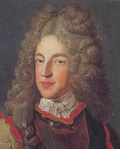 |
James VIII
b. 10/20 Jun 1688, London, England
d. 1 Jan 1766, Rome, Papal States |
| Title: |
Dei gratia Scotie Anglie Francie et Hibernie Rex, Fidei Defensor, etc. = By the grace of God, King of Scotland, England, France and Ireland, Defender of the Faith, etc. (see other style in non-statutory use) |
| Term: |
22 Dec 1715/2 Jan 1716 - 4/15 Feb 1716 |
|
5/16 Sep 1701, succeeded to the claim of the thrones of England and Scotland |
|
22 Dec 1715/2 Jan 1716, started to exercise royal authority upon landing at Peterhead, Aberdeenshire, Scotland [1] |
|
4/15 Feb 1716, ceased to exercise royal authority upon departing the British Isles at Montrose, Angus, Scotland [2] |
| Names/titles: |
Baptised (15/25 Oct 1688): James Francis Edward; private name: James Francis Edward Stuart; byname: the Old Pretender |
|
Prince of Wales [as claimant: 10/20 Jun 1688 - 5/16 Sep 1716]; |
|
Dei gratia Anglie Scotie Francie et Hibernie Rex, Fidei Defensor, etc. = By the grace of God, King of England, Scotland, France and Ireland, Defender of the Faith, etc. as James III [as claimant: 1/12 May 1707 - 4/15 Feb 1716] |
| Biography: |
| Born to King James II of England (James VII of Scotland) and his second wife, Maria Beatrice Eleanor Anna Margherita Isabella d'Este (Mary of Modena), although his birth sparked the rumors that he died at birth and was replaced with another infant in the cradle; was baptized in accordance with the rites of Roman Catholic church; considered a threat to safeguarding the Protestant succession in England; taken to France (10/20 Dec 1688) for safety; brought up in France, residing mostly in Château St. Germain-en-Laye; succeeded to the claim of the thrones of England and Scotland upon the death of his father (5/16 Sep 1701) and received support from King Louis XIV of France; after the Treaty of Utrecht (1713) was negotiated between France and Great Britain, he was forced to move to the Duchy of Lorraine; was acclaimed king when John Erskine Earl of Mar raised the Jacobite standard at Braemar, Scotland, 6/17 Sep 1715; landed at Peterhead, the easternmost point in mainland Scotland (22 Dec 1715/2 Jan 1716) with the prospects for success already fainting after the Battle of Sheriffmuir; arrived at Perth (9/20 Jan 1716), but was unable to rouse the disheartened army; rescinded the plans to hold a coronation ceremony at Scone and boarded a French ship at Montrose, on the east coast of Scotland (4/15 Feb 1716); expelled from France, he finally settled in Rome (1719), where he spend the rest of his life; unfit for another expedition to the British Isles, he appointed (12/23 Dec 1743) his son, Charles, to be regent; unsuccessful rebellion led by Charles (1745-1746) marked an end of Jacobitism as a serious political force in Britain.
|
| Biographical sources: History of the Transactions in Scotland (1817); "Charles Edward Stuart: A Tragedy in Many Acts", by Frank McLynn (London: Routledge, 1988). |
| |
| [1] |
Jacobite Wars (2002), 49-50. |
| [2] |
Jacobite Wars (2002), 52-53. |
|
Image: portrait by Alexis Simon Belle. |

